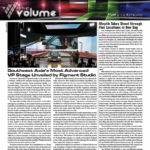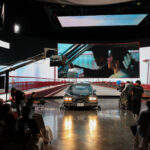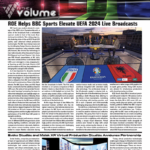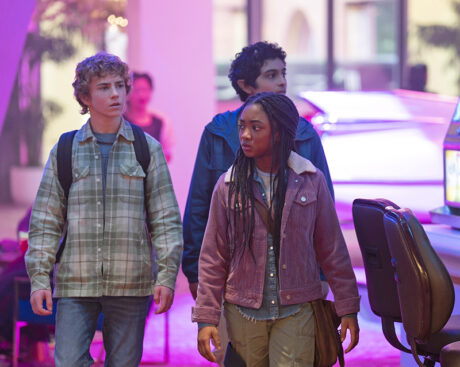
A hit new Disney+ original series follows a young Percy Jackson as he outruns mythical monsters and outwits gods, while embarking on a heroic quest journeying across America to return Zeus’ master bolt. From Camp Half-Blood, a sanctuary for demigod children on the East coast to Los Angeles, with stops in St. Louis, Las Vegas and the Underworld, bringing this story to the small screen was no easy feat. Based on Disney Hyperion’s best-selling book series by award-winning author Rick Riordan, Percy Jackson and the Olympians is both beautifully realistic and yet wonderfully fanciful in the look and feel caught on camera. The task of capturing the adventurers of Percy and his friends, Annabeth and Grover fell to the ASC and CSC Awards-winning cinematographer Pierre Gill, who shot four of the episodes. Gill shared cinematography duties with Jules O’Loughlin and worked closely with Production Designer Dan Hennah. Together they crafted a world of diverse environments both real and mythological. Gill spoke with PLSN about his work on the project and his use of shooting in a volume to realize the many locales while matching them with the footage shot on physical locations or sound stages.
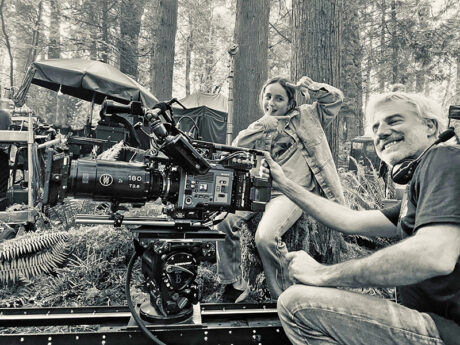
Having shot the first two episodes, you set the tone. Tell me about the visual aesthetic from a cinematography point of view that is at the core of Percy Jackson and the Olympians.
Yes, so by starting a series, you are able to actually establish the look of the entire show. This is done, of course, through discussions with the showrunners, the producers, the directors and Jules O’Loughlin. The thing that we really got locked in to very quickly together, is that they wanted to do a very down to earth, natural show, meaning not a superhero, not over the top Percy Jackson. They wanted to do something very real and get a real kid that is going through a real journey. That was my take also on it.
Once we agree on some of the ideas, then the real work starts with the reality of the scenes, “Okay, so how do we shoot that? Where is it? New York? Oh, are we going to New York?” Well, actually, no, we didn’t go to New York. We shot based in Vancouver, then we mixed a lot of builds on stage, like studios. And what was great is that we did a lot of volume work with ILM. I was working with them very closely on Percy Jackson. We did a lot of this show in that volume. We did do some CGI, which is the more standard blue screen, green screen, but less so on this because of using the volume. We did also do some location shooting and we did some location cheating, meaning ‘yes, they came out of a cab in New York,’ but it’s actually downtown Vancouver with different signs. Another example, is at the opening of episode one, you see young Percy run on the school roof, the teacher runs up to the roof to find young Percy there. Percy sees a centaur and you see New York behind. Actually, we found a location that felt good for the bottom of the buildings, but the background is VFX painted. But then, in that same episode, we go to The Met museum in New York. Percy is seen at the exterior of The Met, which was all shot inside of the volume.

Wow, I thought that was actually a location shoot. I am very familiar with that area by The Met and the look, the quality of light you had, it really captured that location in New York City exactly.
That was all done in the volume. The exterior of the Met was so difficult. It was so hard, because the thing is, it being the exterior of The Met, it was very realistic. And because you’re outside, but really inside the volume, the problem is, to create sun is very difficult. That was a very challenging one. And it was the first day of shooting. And my first day shooting in a volume. But I am very happy with it, it came out very good.
After that, we did the interior Met in the volume as well. I was able to relight The Met completely, working with ILM in a virtual world. They went and they scanned The Met, but you can’t just use that because that is the museum lighting, not our movie lighting; not the DP’s work. So, I relit it. We lighted shelves and added wall lights. A few columns and a few statues are real, but then half of the columns are fake, half the statues are fake. That is when I realized what we could do on the volume and said, “Okay, the volume works like this, so if I light it this way, it should work. If I go this way, it’s too hard.” You have to embrace the medium at that point. I did that with ILM. We made some tests, and it very quickly became very satisfying to work in. We were all like, “Wow, it’s going to look good.” From that, then they went to work making it more precise. When we came to shoot the interior Met, it was a very good day. It was amazing, and ILM is great to work with on this.
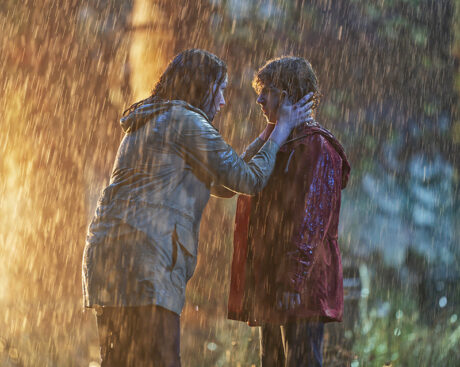
Talk about working with production designer Dan Hennah, to achieve the show’s aesthetic and marrying the cinematography with the production design.
Yes. I work a lot with Dan on this. First of all, I want to say, it was a privilege that I met him. I was like, “Oh, the God of Lord of the Ring.” I was like, “Wow.” For Percy Jackson he came with a lot of concepts and ideas as he started working way before me. I was in prep a long time before the shoot also, but he was there months and months before, because to try to figure out this world as a production designer is a huge task. So, I looked at what he did, the drawing, the concepts. With Dan, it was great because I was able to chip in very easily with him, sometimes about details, things like about the height doesn’t work nice. It’s too high for, because when we have the camera, the actor will be here, or if you want somebody in the foreground, the camera’s too low to see the other one. And he was able to readjust that considering my visual ideas. He was able to reassess a lot of colors also, because I told them I’m very precise on colors and do a lot of tests.
What I try to do, as much as I can, as director of photography, is realize that you are the person that’s going to actually take all the amazing work of all these other beautiful artists who are doing the costumes and the painting and put it inside the camera. I always do very precise test about colors before we paint any wall, before we do any costumes. I get the costume designer to bring in some clothing, and get them to bring some paint samples, a small version, shoot them and try to get the look I’m trying to achieve. That’s another big part of the prep, of course. Then we can see, like, “That blue doesn’t come out nice;” “Oh, that blue is too dark. It looks black.” That is why we always do the test, so it’s very precise and tricky, because you want these things to be easy when you get to shooting. So, yes, I worked with Dan about this a lot, and he was open and understood what I was talking about. Specifically, coming to the volume, I think I got to understand it quite fast, but it’s a very complicated beast. The color is very difficult on that because you have to be able to merge the real set with the wall. The wall is not the same color on every side because of technical reasons. For example, at the end of the episode 8, there’s this big sequence of the ocean and there’s some piers, like a wood stuck in the ground. Some of them are real, some are not. I wanted to see it all loaded in the wall, the different types, different colors; more brown, more gray, more white. We wanted to make sure which one looks like the real thing, which one doesn’t work. Then when it was good, it was blending. You could never know which piece of wood was real and which one was not. This is critical work to do. You have to learn it because it goes with which angle you’re shooting, and how you think you’re going to light it. It’s quite complex, but it was great working with Dan, because I could say, “Dan, it’s going to be too beige. We need more gray.” And he was like, “Okay, no problem.” He understood, and that was cool, because it was making our journey much easier.
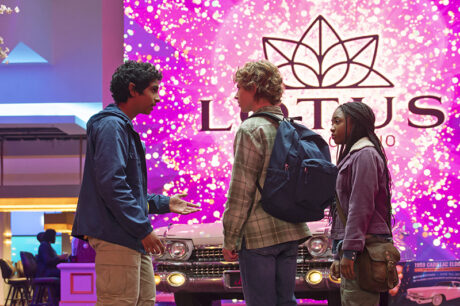
Talk about shooting on an LED volume, and the considerations from a lighting and camera perspective in order to capture in-camera effects.
This is a very important question, because when I got there in prep, I realized that there was a lot of volume work to achieve. I would say, at least 25, 30% of the show, which is a lot. The first thing I knew was that the hardest thing to do is the volume shooting, so no question about it, I knew that was going to be my anchor. All my tests were based on the volume. The first thing I did, I brought a camera on the volume, lenses, tons of lenses, like hundreds of them. I brought Venice and ARRI cameras, and I have somebody in front of the volume and test this one, and test that one, and test, test, test, to find the mix that would give me the most natural look. I knew I wanted to shoot anamorphic, absolutely, because of the proximity to actors. I wanted this to be close to an actor. Anamorphic gets you closer to an actor, and I think you feel it when you watch the show. The close up, you feel the faces are close to you. This is because of anamorphic, and this is very powerful. Also, the anamorphic, it’s nice for the big scope. The tests were crazy. It was so meticulously hard to find the perfect lens. Then at the end, I found these big Cooke lens, Cooke from England, handmade glass, very heavy, beautiful, anamorphic. I mixed them with a Sony Venice 2. I had the very sharp camera with a very beautiful, big, velvety lens. That was a very nice mix. Then, to be honest with you, once I knew I found the mix of my lens and camera, I didn’t even test it outside. People would say, “Well, you don’t want to go test in the park?” No, I don’t need to. It’s done. I have my package. My package is set on the volume, because this is my anchor.
From there, I was always shooting in a way to be able to come back to the volume. When I was going on a location outside in the sun, even if I wanted to keep the show natural, sometimes I added a bit more fill light, for example, because I made some decisions that are based on if I go too far in the location, I’ll never be able to match it in the volume, so I need to keep just a little bit of this edge, because again, the volume is the anchor.
It’s super cool to work on because the human brain doesn’t ask questions. Since we wanted to try to go as natural as possible, the human brain doesn’t let go about that. I always tweak. The exterior Met at the beginning of the movie is on the volume. The interior Met is in the volume. The Minotaur fight is in the volume. Mom with Percy under the rain with the car lights on them is on the volume. And many more scenes, but they all work as natural light to the human brain. I really liked when Percy talks with his mom with the car lights, and she’s pretty wet in the rain. I really liked that because that was something I did on purpose, I said, “I want to bring these lights. I want to flare the lens,” because we’re going to be on the volume and I want to break it. The more you can break the volume, feel like it is natural on a location, the more you’re going to be successful.

With the volume as your anchor, then everything needs to marry back to that, so talk about how you did that when shooting on location or a soundstage.
Well, first of all, shooting exteriors, you’re stuck with if it’s going to rain, it’s going to rain, if it’s going to be sunny, it’s going to be sunny. Now, you cannot change the shooting schedule on a show like that, because some scenes, like Capture the Flag at the camp, you have some 200 kids all dressed up with their little sword, waiting for you to roll. You cannot say, “Hey, well, come back tomorrow.” What I try to do is to first hope to be lucky. For this, I wanted to have the sun, and we got lucky and had a lot of it, which was great. But I made sure that I kind of kept track of the scenes that are next. After the Capture the Flag sequence, for example, the next scene is in the volume. So, I talk to the director and say, “Well, now, we’re here at the camp and the kids are waiting with their swords, and there’s a big sun, so can they walk and finish here in the shade, so there could be less sun on them? Maybe there’s dimples of sun at the end, and then I’m going to put more fill light on their face.” That lets me have a softer transition into a world that I cannot control as well as the outside for hard contrast, for example. I tried to always think about what was coming, I always added this factor in my head. I think, “Oh, we’re going there in two scenes, so is it okay?” “Yeah, it’s okay,” or, “No, it’s not okay,” so, how I could handle that exterior. That’s really the reality of it. Always thinking about the transitions.

Talk about working with your camera and electrics team.
I had an amazing crew, one of the top crews in Vancouver. I was very fortunate, because I did the pilot for another series, before I got the call for Percy Jackson, so I had this crew already, just as I was getting ready to leave. When I got Percy and they were shooting in Vancouver, I booked them. I had a great gaffer, James McMurachy, and a grip, Will Parrot, and I had, also on this show is very important, I had a rigging gaffer, Sean Oxenbury. And I had a rigging grip, David McIntosh. So, they were the four and they are so great. It was really good, because when you have a rigging gaffer and a rigging grip, for a DP, it saves you a lot of work.
Also, one of the most important people that are part of the new filmmaking is the board op. Without a good board op, now you’re basically kaput, because on a show like this, you have 250 fixtures that are on DMX, and the board op and my gaffer are the key to making that all work. They are two people that are very important to me. One of the biggest scenes in Percy Jackson is episode five, which is the casino. It’s gorgeous, and you’ll see the work of my board op, his name is Dan Holt. It was amazing the speed he was working, he was phenomenal. All of the casino was built from scratch in an empty building, a cement room. When you see the casino scene, all of it is built by the team from Percy Jackson. It’s massive, every window, every ceiling, every light, every piece of it, from the carpet to, to the ceilings.
What I did in the casino to make it more interesting and to fill the space, because even if it was huge, it’s never big enough, of course, I divide everything by colors. If they come in, it’s more pink, and orange, and as they make their way through the casino, it becomes more yellowish and green. They go around, it’s just purple-ish. They go in this place, it’s just gold. They come back, and it is the same place, but I change all the colors to another, say deep orange. Then you travel with them, like they are walking through a much larger space. To do this is a lot of work and you have to go fast, because it’s live. You do this live on the show, on the shoot day. You have to change with them moving.
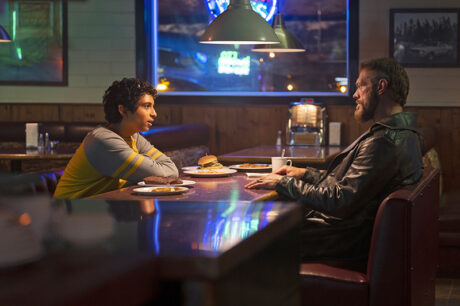
Do you use a lot of automated lighting, or is it just more control of LED sources?
I always ask to have in every setup I’m doing, even if I’m not sure, I put always four automated rock and roll lights. It’s always a lifesaver on a shoot like this. You sometimes say, “I am missing something. Can you bring the moving light? Focus it narrow here.” In the casino, I use them moving left to right to create just some movement and stuff like that. I’ve done some sequences underwater also in the show, and those lights create a bit of movement in the water. It helps you out to have that ability to dial in some extra light.
Were there any other collaborations on the film you’d particularly like to mention that influenced or affected your final work on the series?
Yes. One of the most beautiful collaborations was with the ILM team. It was phenomenal. All these wonderful people… I cannot give all the names, there’s too many, but there’s some key people that are, there’s Sonia Contreras who’s in charge of the volume, she’s the mother of the volume. She helped me get things going as I needed. When we started to do, for example, the exterior of The Met, I figured out very quick what was the trouble with the volume to me. I said to her, “Sonia, I need to control the sun myself and those clouds myself. It cannot be your team, because there are 20 people behind a computer. The only way for me to make it work is if I can change the cloud for the shot.” Because I do my own color correction, I have this little gadget with knobs, and I do all my color live. I said, “You see, I need the sun on my thing like this.” She goes, “Okay,” she went to her engineer and two days later they had created for me this crazy, very complicated piece of software. I had in my hands control of the sun. I could place it exactly where I wanted. That changed everything. I was changing their clouds. Sometimes people would say, “Yeah, but the sun was there.” I said, “I don’t care. Nobody cares.” Most people, when they come out of a movie, they say, “Oh, it was so beautiful, or it was so good.” That’s all that counts.
Half of these shots, the sun is behind. When you cut around, the shot is behind. If you have Julia Roberts, the sun would be behind her, not in her face. It’s going to be like this in her hair. You cut to Richard Gere, the sun is behind him. That’s it. That’s the way it works. It’s bottom line, that’s what we do. At the beginning for them, they were like, “No, but there’s a logic.” I said, “No, there’s no logic. The only logic is that the shot works.” When a shot works, because you look at the actor talking, that’s all that counts. It goes down to one thing. Do you see his eyes, or you don’t see his eyes? For me, that’s very important. If you watch the episodes, you’ll see their eyes. They’re present. I work for it. I work for faces with filters, also, I changed the shadow and shade of the faces. So, this is very important when they gave me that control, when they were able to create that tool, and for them, it was like a first, and they were like, “Oh, my god, this is great.” Then they gave me afterward the contrast, and the gammas, and stuff that I was asking for, because it’s too hard to match without enough time to do it. It’s just time-consuming, but the volume is amazing. Also, I worked with Jeff White, which is one of the most amazing guys from ILM, who was also part of building this world. He is so talented. Like I say, I would like to shoot in this very often I think in the near future, because though there still needs a bit more updated technology and it takes so much brain power, but it’s a great tool to work with.
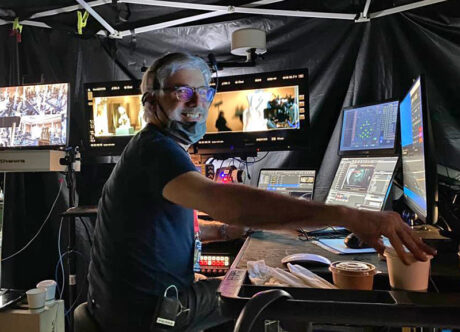
Is there anything else you’d like to mention about working on Percy Jackson?
It was a great journey, and the actors were amazing. They’re such nice kids, so fun. Every day they came on set, it was just joy. There was no ego, it was just fun, and very respectful, and very professional, and very challenging.
What’s some advice you’d have for someone shooting in an LED Volume for the first time?
What I would say to a DP, you have to get a lot more involved than you think. You don’t just come in, it’s not the world of the CG people to tell you how it’s going to work. You work with them. The thing is that if you don’t pay attention, they will build a gorgeous world that doesn’t apply to what you need, because it’s not their exact job to be the cinematographer at the end. This is very important, because if you work and you get with them, of course, you’re not the boss and they know better than you about the volume, of course, but you have to work with them right away. That’s what I did. I plunged completely into it, and I was able to make some good calls, like calls to change trees, change the light, change the size. I was like, “They’re too big.” I was telling them all the time, “Look at me,” and I was taking my phone. I said, “Look, this is you against that tree, meaning, what do you see? You just see a face with brown, but there’s nothing. Make it smaller.” Then you see brown and you see sky, and then there’s depth. I was working with them a lot to preserve what my job is to do, make a 3D world into a 2D screen. That’s the job of a DP. A good DP makes three-dimensional images. The human, well, we’ve seen 3D. When you see these great movies that are wonderfully shot, it’s because the DPs are creating 3D on a 2D screen, not with a 3D camera, just like with one camera, but the lighting, and the lens, and the shallow depth, and everything you create.
